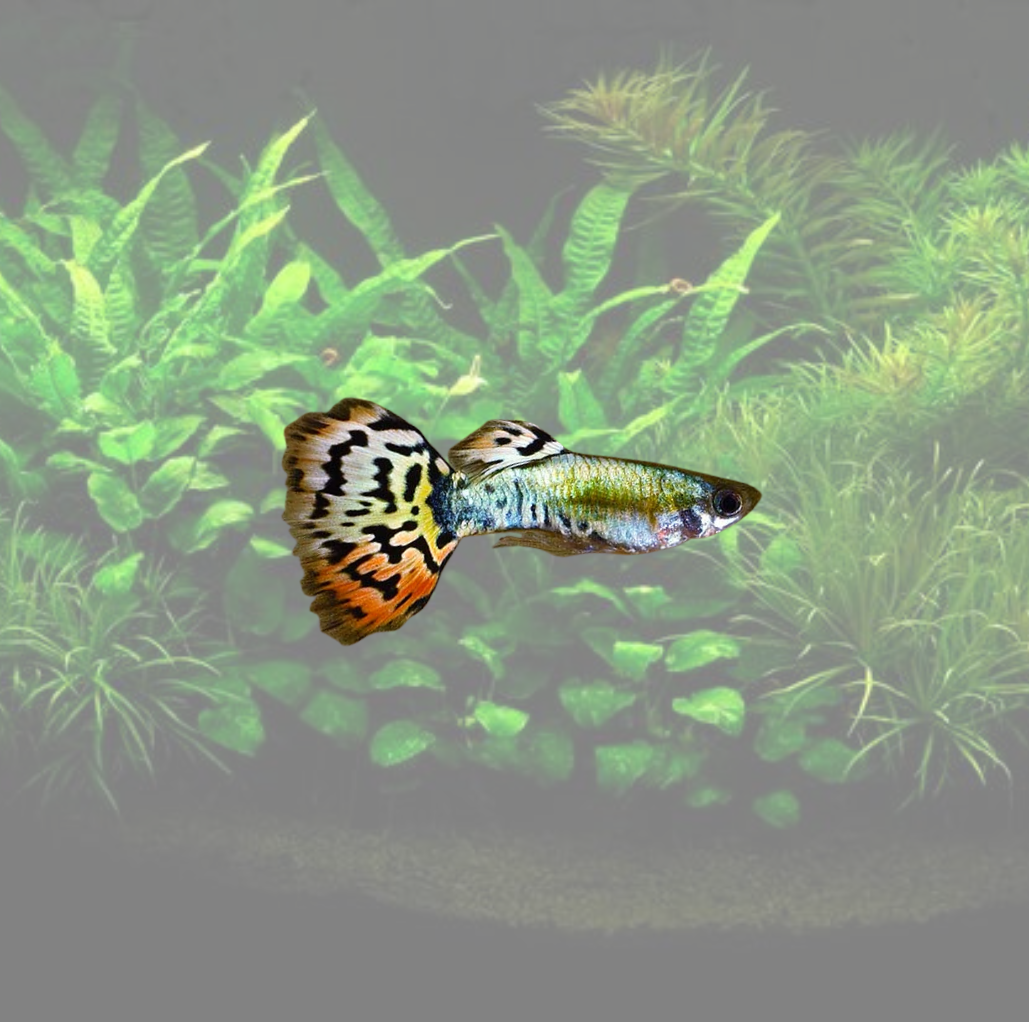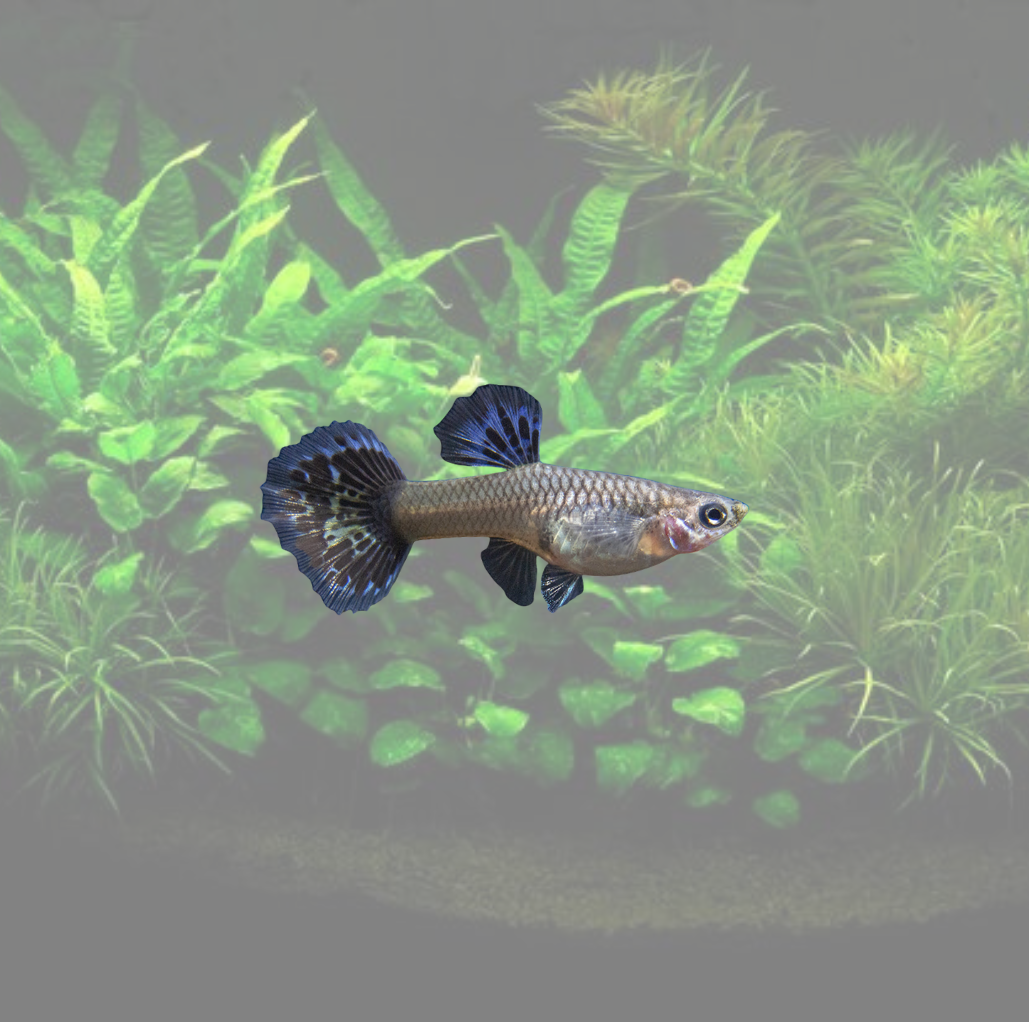Poecilia reticulata
Guppy

科学分类
快速统计
水族箱建造信息
关于此物种
基本描述
详细描述
孔雀鱼原产于南美洲的淡水溪流和河流,是一种因其强大的生命力和活跃的行为而备受珍视的物种。在其自然栖息地,它们生活在水流缓慢、温暖的热带水域,水的矿物质含量范围很广,这造就了它们在人工饲养环境下的非凡适应性。它们甚至能忍受微咸水环境,这证明了其顽强的生命力。对于讲究的爱好者来说,复制这种环境需要一个过滤良好、水流柔和、水温稳定的水族箱。作为一种群游鱼类,当它们成群饲养时,会表现出最自然、最自信的行为;单独的个体容易感到压力。群体动态使得观察它们复杂的社交互动成为可能。
从生理学上讲,这种鱼的新陈代谢率很高,为其持续活跃的生活方式提供了能量。这种高能量水平决定了特定的喂食方案;每天多次少量喂食优于一次大量喂食。多样化的杂食性饮食对其健康和活力至关重要。虽然高品质的薄片或颗粒饲料可作为主食,但其饮食应辅以蔬菜物质和富含蛋白质的食物,例如冷冻或活体饲料。这种多样性不仅确保了营养均衡,还鼓励了其觅食行为。它们的活动集中在水体的上层和中层,这使它们成为一种非常显眼和引人入胜的物种。在考虑混养伙伴时,它们的小体型和雄鱼特有的长鳍使其容易受到较大型、具攻击性或有咬鳍习性的鱼类的伤害。理想的伙伴是其他体型小、性情温和且水质参数要求相似的物种。尽管它们生命力顽强,但相对于其体型,它们产生的废物量中等,因此需要定期换水以维持低硝酸盐环境,并确保它们能度过其完整但相对短暂的生命周期。
科学描述
网纹花鳉(Poecilia reticulata)是花鳉科(Poeciliidae)的一种小型淡水鱼,该科以其胎生的繁殖策略而著称。它原产于南美洲东北部的多个水系,其生态上的成功主要归功于其非凡的适应性。该物种呈纺锤形体型,这是一种为适应在低流速水生环境中进行机动和持续游动而优化的进化特征。显著的性二态性是其一个关键特征;雄鱼通常体型较小,并表现出广泛的色彩和形态变异,包括华丽的鳍,而雌鱼体型较大、更粗壮,色彩也较单调。
该物种对广泛的理化水质参数表现出很强的耐受性。它在温暖的热带温度和从微酸性到中度碱性的pH值范围内都能茁壮成长。此外,它既能适应极软的水质,也能适应极硬的水质,这体现在它对广泛的总溶解固体量的耐受性上。其在低盐度环境下生存和繁殖的能力进一步凸显了其生理可塑性。在代谢方面,网纹花鳉的能量消耗很高,这与其高活动水平、持续游动和需要频繁摄取营养相对应。这种高新陈代谢导致了中等的耗氧量和中等的生物负荷系数,需要足够的水族箱过滤和气体交换。作为一种杂食性动物,其在原生环境中的饮食包括藻类、硅藻、无脊椎动物和有机碎屑。这种广谱的摄食策略已被世界多地用于蚊子幼虫的生物防治计划中。网纹花鳉种群数量稳定且分布广泛,目前被国际自然保护联盟(IUCN)列为无危物种。
繁殖描述
繁殖孔雀鱼被认为异常容易,在一个健康、维护良好的水族箱中,通常无需水族爱好者的任何特殊干预即可自发进行。它们是一个多产的物种,这也是它们在水族爱好者中广受欢迎和普遍分布的主要原因。
首先,由于强烈的性二态性,辨别性别非常简单。雄鱼体型明显较小,拥有绚丽的色彩和长而华丽的鳍。其最明确的特征是交接器(gonopodium),这是一种特化的、棒状的臀鳍,用于将精子输送给雌鱼。雌鱼体型要大得多,也更强壮,色彩较为柔和,并有一个标准的扇形臀鳍。怀孕时,雌鱼的臀鳍附近会出现一个被称为胎斑(gravid spot)的深色区域,随着鱼苗的发育,该斑点会变得更大更深。对于专门的繁殖设置,强烈建议每只雄鱼搭配两到三只雌鱼的比例。这可以防止单只雌鱼因雄鱼持续的求偶追逐而感到压力或精疲力竭。
作为胎生鱼,它们遵循一种体内受精的繁殖方式。雌鱼将发育中的胚胎在体内携带约一个月的妊娠期,具体时长可能受水温、饮食和压力水平的影响。然后,它会产下一窝完全成形、可以自由游动的幼鱼,称为鱼苗。繁殖中的一个重大挑战是亲代吞食现象;成鱼(包括母鱼)会毫不犹豫地吃掉鱼苗。为了最大限度地提高存活率,建议提供充足的躲避物,例如茂密的水生植物(如浮萍或爪哇莫斯),以便鱼苗藏身。或者,在临产前,可以将怀孕的母鱼移至一个装有繁殖盒或茂密植物的独立专用繁殖缸中。鱼苗一出生就是独立的,应喂食精细碾碎的薄片饲料、粉末状的鱼苗专用食品或微小的活体食物,以支持其快速生长。
性二型
生成可打印卡片
为此生物创建可打印卡片,以便在您的商店或水族箱中展示。卡片包含二维码,可快速访问更多信息。









